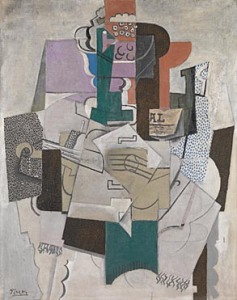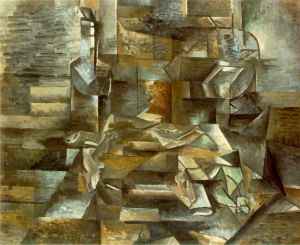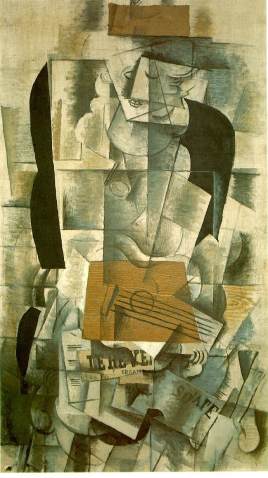Cubism
(1907-1922)
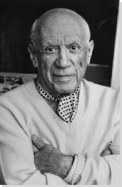
“Cubism was one of the first truly modern movements to emerge in art. It evolved during a period of heroic and rapid innovation between Pablo Picasso and Georges Braque. The movement has been described as having two stages: ‘Analytic’ Cubism, in which forms seem to be ‘analyzed’ and fragmented; and ‘Synthetic’ Cubism, in which newspaper and other foreign materials such as chair caning and wood veneer, are collaged to the surface of the canvas as ‘synthetic’ signs for depicted objects. The style was significantly developed by Fernand Léger and Juan Gris, but it attracted a host of adherents, both in Paris and abroad, and it would go on to influence the Abstract Expressionists, particularly Willem de Kooning.
And, “it lies at the root of a host of early modern styles such as Dada, Constructivism, and De Stijl, whilst also being the impetus for the later, romantic reactions such as Surrealism, which rejected Cubism’s sometimes quasi-scientific approach to perception. The ideas in the movement also fed into more popular phenomena, like Art Deco design and architecture” (“Cubism”).
More specifically, Cubism “arose out of the need to define and represent the then new modern reality. This new reality was complex and ambiguous, shaped by new inventions, philosophical speculation and cultural diversity. The new technology and scientific discoveries were radically changing the pace of life and the way society perceived the nature of things. Whereas in the past, life had been static, science and technology were now forcing modern man to experience time, motion and space more dynamically. […]
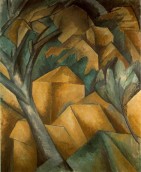
Furthermore, the ambiguity and sense of uncertainty generated by this new rush of stimuli was interpreted by the theory of relativity that evolved through F. H. Bradley, Whitehead, Einstein, and the new mathematics. What these philosophical theoreticians suggested was that we live in a world of shifting perspectives, where the appearance of objects is in a constant flux depending on the point of view from which it is seen.
Finally, the experience of reality was also being altered by the cultural interactions taking place between the East and West, the primitive and the industrialized. In other words, each culture brought along with it a new, idiosyncratic way of looking at things, and the interchange occurring between cultures obscured the perception of truth. Relativity became everything” (“New Vision”).
Of course, art is one way to deal with changing times. “The problem facing the modern artist became how to formally depict this new dynamic vision of life. For the painter, specifically, the dilemma became representing the flux of time, motion and space in a medium that lent itself to the mere capture of the fleeting moment. Cubism was born as a response to this predicament, and it is no accident that the movement was a Parisian phenomenon, considering the city’s artistic legacy and its magnetic ability to attract the most gifted young artists and writers from all over the world. Paris offered them great art museums, a tradition of moral and artistic freedom, and an artistic bohemia where they could live cheaply on the margin of bourgeois society” (“New Vision”).
Key Ideas
- Analytic Cubism staged modern art’s most radical break with traditional models of representation. It abandoned perspective, which artists had used to order space since the
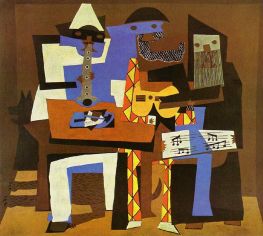
Picasso’s The Three Musicians (1921) Renaissance. And it turned away from the realistic modeling of figures and towards a system of representing bodies in space that employed small, tilted planes, set in a shallow space. Over time, Picasso and Braque also moved towards open form – they pierced the bodies of their figures, let the space flow through them, and blended background into foreground. Some historians have argued that its innovations represent a response to the changing experience of space, movement, and time in the modern world.
- Synthetic Cubism proved equally important and influential for later artists. Instead of relying on depicted shapes and forms to represent objects, Picasso and Braque began to explore the use of foreign objects as abstract signs. Their use of newspaper would lead later historians to argue that, instead of being concerned above all with form, the artists were also acutely aware of current events – in particular WWI.
- Cubism paved the way for geometric abstract art by putting an entirely new emphasis on the unity between the depicted scene in a picture, and the surface of the canvas. Its innovations would be taken up by the likes of Piet Mondrian, who continued to explore its use of the grid, its abstract system of signs, and its shallow space.
Key Innovations
At the end of Cubism, we see the major innovations solidified:
- bringing together familiar scraps and unfamiliar forms in order to give shape to a particular sense of urban life
- exploring the individual experiences associated with public spaces and urban recreation
- using the language of publicity and commerce in an ambiguous manner to suggest a multiplicity of contradictory meanings, especially through puns
- capturing the new sense of simultaneity of diverse experiences-the fusion of objects, people, machines, noises, light, smells, etc.
Major Artists
- Pablo Picasso
- Georges Braque
- Fernand Léger
- Juan Gris
- Robert Delaunay
- Sonia Delaunay
Pablo Picasso
(Spanish, 1881-1973)
“Pablo Picasso was the most dominant and influential artist of the first half of the twentieth century. Associated most of all with pioneering Cubism, alongside Georges Braque, he also invented collage and made major contributions to Symbolism and Surrealism. He saw himself above all as a painter, yet his sculpture was greatly influential, and he also explored areas as diverse as printmaking and ceramics.
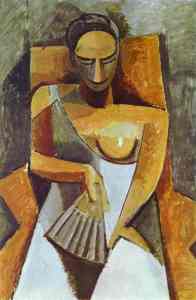
Georges Braque
(French, 1882-1963)
Assignment:
On deck: Surrealism
Works Cited
“Cubism.” The Art Story: Modern Art Insight. Web. 29 June 2015.
“Cubism: A New Vision.” Miami Dade College. Web. 29 June 2015.
“Georges Braque.” The Art Story: Modern Art Insight. Web. 29 June 2015.
“Pablo Picasso.” The Art Story: Modern Art Insight. Web. 29 June 2015.
